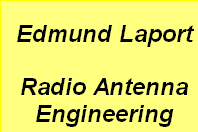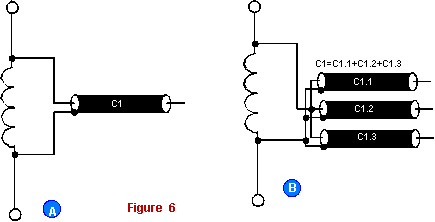

Antentop is FREE e-magazine devoted to Antennas and Amateur Radio an
Special page devoted to
Multirange Trap Antennas

Custom Search
|
ANTENTOP-
02- 2004, # 006 |
Multirange
Trap Antennas |
|||||
|
|
||||||
|
Figure
6 A coaxial cable capacitor |
||||||
|
antenna
need resonance (a quarter wave) counterpoises for each operation
range. Use not less than two counterpoises. If the antenna is
placed at a small altitude above a metal roof and braiding of
feeding coaxial cable have good electrical contact with the metal
roof, the antenna can be used without any counterpoises. Antenna
feeding: Quite possible to use a 50- Ohm coaxial cable
for vertical trap antenna feeding. Also it is possible to use
a two wire line for dipole and vertical trap antenna feeding.
In this case it need ATU between the line and the transceiver. A
trap capacitor: A high voltage is at a trap capacitor
when the antenna works to transmission. So it need a high voltage
capacitor trap to be used at a trap. Such capacitor is costly
and rather rare. Hams often use a length of a coaxial cable instead
of a high-voltage capacitor. A 50- 0hm coax has near 100-pF/meter,
a 75- 0hm coax has near 70-pF/meter. Coaxial cable capacity can
be find off from a data sheet for the coaxial cable or is metered
practically. Figure 6 shows
a coaxial cable capacitor. For a capacitor with a small capacity
(up to 30-pF) it is possible to use whole coaxial cable length,
see Figure 6A. For a capacitor
with a high capacity cut the coaxial cable on to several lengths,
as it shown in Figure 6B.As
a high-voltage capacitor in trap it is possible to use a bilateral
PC-board by width of 1 to 3 millimeters. In this case capacitor
get more bulky the made on coaxial cable basis. It is possible
to tune the PC- capacitor on necessary capacity by slitting a
foil on one of two sides of this capacitor. Do not forget about
atmospheric protection of the trap capacitor. Other
way for trap design: It seems to me in the end of 70s
in different radio amateur literature were appeared articles about
using "coaxial cable trap" for W3DZZ. There is very
simple method for trap making. Figure
7 shows the trap. It is wise way for trap design, but
radio amateur should have an experience using the method. In different
radio amateur literature there are a lot of data for design of
the trap, but classical methods are described at reference [6]. References: 1.
(8) By Alois Krischke : Rothammels Antennenbuch.- Franckh- Kosmos,
Verlags- GmbH@Co., Stuttgart, 1995,
11 edition. 2.
Jay Rusgrove, WA1LNQ: The Cheapie GP // QST, 1976, February, p31. 3.
(9) Morgan h. K. : Multifrequency Tuned Antenna System. - Electronics,
vol. 13, August 1940, pp. 42-50. 4.
Buchman C. L., W3DZZ : The multimatch Antenna System. // QST,
March 1955, pp.22-23, 130. 5.
The Radio Amateur's Handbook, 1970, by ARRL publication. 6.
The ARRRL Antenna Book, 19 Editions // ARRL Amateur Radio, 2000. |
Figure 7 A
coaxial cable trap |
|||||
|
|
|
|||||
|
Page
61 |
||||||
47 48 49 50 51 52 53 54 55 56 57 58 59 60 61
 |
 |
 |
 |
Just for Fun:

Powered byIP2Location.com
Thanks for your time!
Last Updated:
February 23, 2020 20:46






